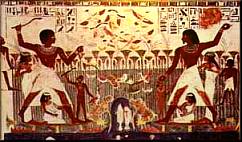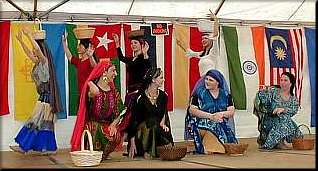|
|
|||
Middle Eastern Dance, a Beautiful, Ancient, yet Misunderstood Art by Hala Fauzi I originally wrote this article as a handout for Redwood School, in Saratoga, California, when I gave them a workshop and presentation about Folkloric dance in Egypt. I thought the article would be of interest to the dance community as well. History: Current
forms:
In Arabic, this dance is simply called "raks", which translates to "dance". If it needs to be differentiated from other forms of Western dance, it is referred to as "raks sharki" which translates to "Oriental dance". No one knows why it got to be called "Belly dance" in the western world. Some historians believe that during Victorian times, when the Westerners first came into direct contact with this dance, it might have looked to them like the dancer was moving her belly, which is in fact a very gross misrepresentation. In Middle Eastern dance, like many eastern traditions and arts, there is a strong sense of grounding and connection to the earth. The same is true of martial arts like karate and other forms of eastern dances like Indian dance. The artist initiates the moves from the center of gravity, which is the belly and hip area. Unfortunately, associating a dance with a body part does not do the dance justice at all. In Middle Eastern dance, like many Eastern and Western expressive arts, the whole body and soul are involved in creating a beautiful, live expression. Calling it "belly dance" is like calling ballet "tip-toe dance". Even though the toes are involved and do attract the attention of the inexperienced eye, the dance is much more than the toes. If the dancer's whole body, soul and spirit are not involved, there will be no dance and no beauty. It will merely be mechanical movements. In Middle Eastern dance there are some movement isolations that might make the onlooker believe that, for example, only the hip is moving, or only the arm is moving. In executing these isolated movements, however, the dancer can only present the movement beautifully and gracefully through many years of training, repetition, and the full involvement of his or her entire mind and body.
When Westerners began to colonize in the Middle East, the dance that was native to the area also began to attract their attention and documentation.
In ancient times, it is believed that this dance was performed in temples and sacred places for spiritual purposes. Over time, and as the whole world moved from matriarchal heritage to more patriarchal modes of thinking, that which was spiritual became detached from the physical and the dance took a more social and cultural form. People have continued to dance through the ages to express their wide variety of emotions, moods, and to celebrate social occasions, and significant events in their lives. In more recent history, Egypt for example, Middle Eastern dance has continued to flourish and grow as an art.
Dancing survived as a private expression of joy for major life events and in indigenous communities that were not affected as much by the Western ideals. In the Westernized sections of society, dance took the form of nightclub and adult entertainment. In current times, the dance is becoming increasingly popular in the West and is experiencing a revival of sorts from the same Western culture that aided in its decline in the Middle East. Many women and men in the West are finding raks liberating, beautiful, and a natural way to express their unique body and style without having to conform to strict physical standards or unhealthy body postures. People of all ages, genders, body types and skill levels are able to express themselves beautifully and naturally through the fluid moves of this dance without feeling self-conscious about their bodies. Therefore, they experience a level of freedom that may not have been accessible to them through any other form of dance. *Note: For more
information, please refer to "Ancient Egyptian Dances" by
Irena Lexova: "The dance consisted of a succession of figures
in which the performer endeavored to exhibit a great variety of gestures.
Men and women danced at the same time or in separate groups. Some
danced to slow airs, adapted to the style of the movements; others
preferred lively steps regulated by an appropriate tune. Sometimes
when dancing, the women accompanied themselves on lutes or pipes."
Lexova page 7. Have
a comment? Send us a letter! Ready
for More? 8-26-02 "Still
More Dancing in the '70s" By Kalifa 8-14-02 Kayla’s
Travel Journal -Ferry to Kadikoy; Kayla’s Furniture Safari
by Kayla Summers | |||









